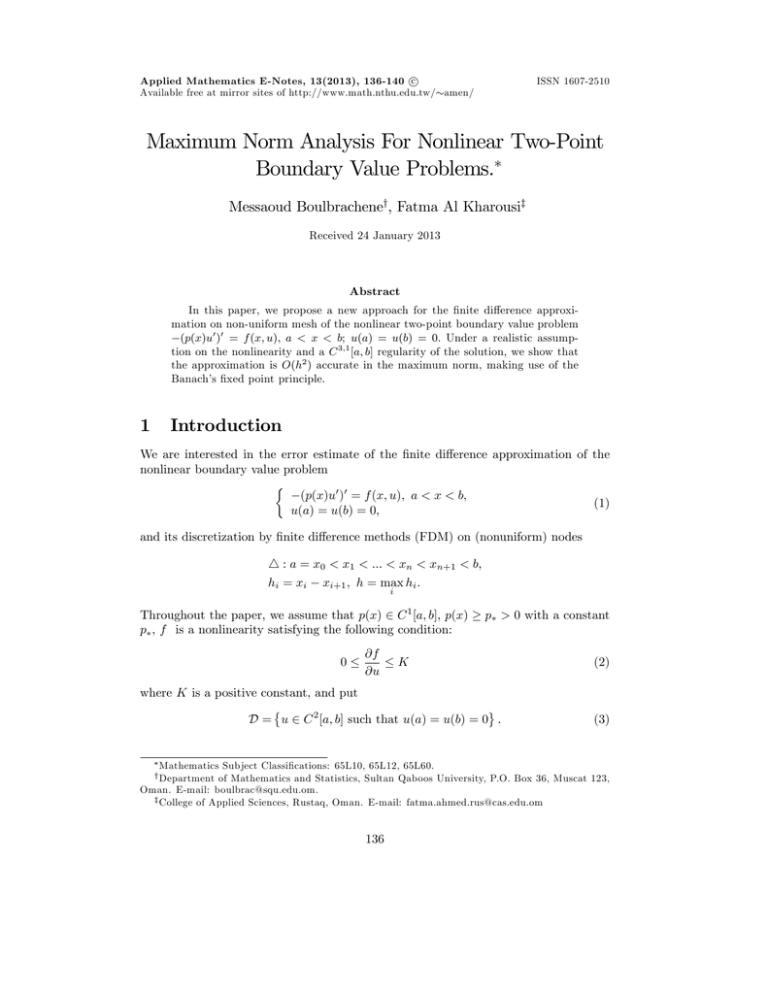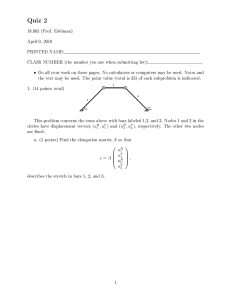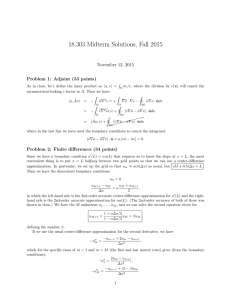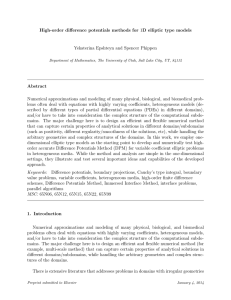Document 10677517
advertisement

Applied Mathematics E-Notes, 13(2013), 136-140 c Available free at mirror sites of http://www.math.nthu.edu.tw/ amen/ ISSN 1607-2510 Maximum Norm Analysis For Nonlinear Two-Point Boundary Value Problems. Messaoud Boulbracheney, Fatma Al Kharousiz Received 24 January 2013 Abstract In this paper, we propose a new approach for the …nite di¤erence approximation on non-uniform mesh of the nonlinear two-point boundary value problem (p(x)u0 )0 = f (x; u); a < x < b; u(a) = u(b) = 0. Under a realistic assumption on the nonlinearity and a C 3;1 [a; b] regularity of the solution, we show that the approximation is O(h2 ) accurate in the maximum norm, making use of the Banach’s …xed point principle. 1 Introduction We are interested in the error estimate of the …nite di¤erence approximation of the nonlinear boundary value problem (p(x)u0 )0 = f (x; u); a < x < b; u(a) = u(b) = 0; (1) and its discretization by …nite di¤erence methods (FDM) on (nonuniform) nodes 4 : a = x0 < x1 < ::: < xn < xn+1 < b, hi = xi xi+1 ; h = max hi : i Throughout the paper, we assume that p(x) 2 C 1 [a; b]; p(x) p , f is a nonlinearity satisfying the following condition: 0 @f @u p > 0 with a constant K (2) where K is a positive constant, and put D = u 2 C 2 [a; b] such that u(a) = u(b) = 0 : (3) Mathematics Subject Classi…cations: 65L10, 65L12, 65L60. of Mathematics and Statistics, Sultan Qaboos University, P.O. Box 36, Muscat 123, Oman. E-mail: boulbrac@squ.edu.om. z College of Applied Sciences, Rustaq, Oman. E-mail: fatma.ahmed.rus@cas.edu.om y Department 136 M. Boulbrachene and F. A. Kharousi 137 The usual discretization of (1) by the …nite di¤erence method is 8 Ui+1 Ui Ui Ui 1 1 < pi+ 12 pi 12 = f (xi ; Ui ); Lh Ui = !i hi+1 hi : U0 = Un+1 = 0; 1 i n; (4) where ! i = 12 (hi + hi+1 ); xi+ 12 = 12 (xi + xi+1 ); pi+ 12 = p(xi+ 21 ) and Ui denote the approximation of the exact value u(xi ). In a matrix form, problem (4) reads as follows HAU = F (U ) (5) where H = diag 1 1 ; :::::::; !1 !n ; t U = (U1 ; :::; Un )t ; F (U ) = [f (x1 ; U1 ); :::; f (xn ; Un )] ; 2 3 a1 + a2 a2 7 6 a2 a2 + a3 a3 1 7 6 A=6 7 and ai = pi . . .. .. h 5 4 i a n an 1 2 : an + an+1 Thanks to Yamamoto [5], the inverse matrix of A enjoys the following interesting properties: A 1 = G(xi ; xj ) (6) where G(x; ) denotes the Green’s function for the operator L= (pu0 )0 : D ! C[a; b] and jG(xi ; xj )j M (7) where M is a is a constant independent of h. Error estimates of the approximation by …nite di¤erence methods for problem (1) have been extensively discussed by several authors since the early sixties (cf.,e.g., references [1–6]). In this paper, we propose a new and simple approach to derive error estimate of the above …nite di¤erence approximation. Indeed, combining assumption (2) with the properties (6) and (7), we characterize the solution of the discrete problem (5) as the …xed point of a contraction. As a result of this, we also show that, if the exact solution is in C 3;1 [a; b], then the approximation is O(h2 ) accurate in the maximum norm, that is max jUi ui j Ch2 1 i n where ui = u(xi ) and C is a constant independent of h. For existence and uniqueness of solutions to the continuous and discrete problems (1) and (5), we refer to [5]. Next, we shall characterize the solution of the discrete problem (5) as the unique …xed point of a contraction. 138 Maximum Norm Analysis for Two-Point Boundary Value Problems 2 Characterization of the Discrete Solution as a Fixed Point of a Contraction Consider the mapping T : Rn ! R n V ! TV = where is the unique solution of the linear system HA = F (V ): (8) LEMMA 1. Let (6) and (7) hold. Then for h su¢ ciently small, we have K A 1 1 H 1 1 < 1: = PROOF. We know that H 1 = diagf! 1 ; :::; ! n g: Then 1 H Since A 1 1 h: = G(xi ; yj ) is tridiagonal and jG(xi ; yj )j A 1 1 M , we observe that 3M: So, choosing h su¢ ciently small, we get the desired result. THEOREM 1. Let conditions of Lemma 1 hold. Then T is a contraction with rate of contraction equal to : PROOF. Let U; V in Rn and = T U; = T V be the respective solutions of equation (8) and W = U V . In order to simplify notations, we denote f (xi ; Ui ) by f (Ui ) and @f by f 0 . Then, we have @u F (U ) F (V ) = [f (U1 ) and 1 [f (Ui ) Wi f (Vi )] = So f (V1 ); :::; f (Un ) Z t f (Vn )] 1 f 0 (Vi + (Ui Vi ))d : 0 jf (Ui ) f (Vi )j K jUi Vi j max jf (Ui ) f (Vi )j Kmax jUi and i i Vi j M. Boulbrachene and F. A. Kharousi 139 or kF (U ) F (V )k1 On the other hand, we have kT U T V k1 = k = A 1 A 1 A 1 k1 1 H K kU (F (U ) H 1 1 H 1 kU 1 V k1 : F (V )) kF (U ) 1 1 V k1 : K kU 1 F (V )k1 V k1 Thus, making use of Lemma 1, T is a contraction. 3 Error Estimate Let U = T [u] be the unique solution of the linear system HAU = F ([u]) (9) t where u is the solution of problem (1), [u] = [u1 ; :::; un ] ; and t F ([u]) = [f (x1 ; u1 ); :::; f (xn ; un )] : Then we have the following error estimate. LEMMA 2. Assume u 2 C 3;1 [a; b]. Then, there exists a constant C independent of h such that (10) U [u] 1 Ch2 where U [u] 1 = max Ui 1 i n ui : For more details regarding the regularity assumption C 3;1 [a; b] of u, we refer to [5]. PROOF. Since F ([u]) is the restriction of f (u) to nodes fxi g, then problem (9) is the discrete counterpart of (1). So, making use of [6], we get the desired result. THEOREM 2. Let u and U be the solutions of (1) and (5), respectively. Then there exists a constant C independent of h such that k[u] Ch2 : U k1 PROOF. Since U = T U and U = T [u], making use of (10) and the fact that T is a contraction, we get k[u] U k1 k[u] U 2 T [u]k1 + kT [u] [u] 1 + kT [u] Ch + k[u] U k1 : U k1 T U k1 140 Maximum Norm Analysis for Two-Point Boundary Value Problems So, k[u] U k1 Ch2 : 1 References [1] T. N. Tikhonov and A. A. Samarskii, Homogeneous di¤erence schemes of a high degree of accuracy nets, U.S.S.R. Comp. Math. Phys., (1961), 1465–1486. [2] F. de Hoog and D. Jackett, On the rate of convergence of …nite di¤erence schemes on nonuniform grids, J. Austral. Math. Soc. Ser. B, 26(1985), 247–256. [3] H. O. Kreiss, T. A. Manteu¤el, B. Swarts, B. Wendro¤ and A. B. White, Jr., Supra-convergent schemes on irregular grids, Math. Comp., (1986), 537–554. [4] T. A. Manteu¤el and A. B. White, Jr., The numerical solution of a second order boundary value problem on nonuniform meshes, Math. Comp., 47(1986), 511–535. [5] T. Yamamoto and S. Oishi, A Mathematical theory for numerical treatment of nonlinear two-point boundary value problems, Japan J. Indust. Appl. Math., 23(2006), 31–62. [6] T. T. Yamamoto, Discretization principles for linear two-point boundary value problems, Numer. Funct. Anal. & Optimiz., 28(2007), 149–172. [7] F. A. M. Al Kharousi, Mathematical and Numerical Analysis of Nonlinear TwoPoint Boundary Value Problems, Master Thesis, Sultan Qaboos University, (2008).






